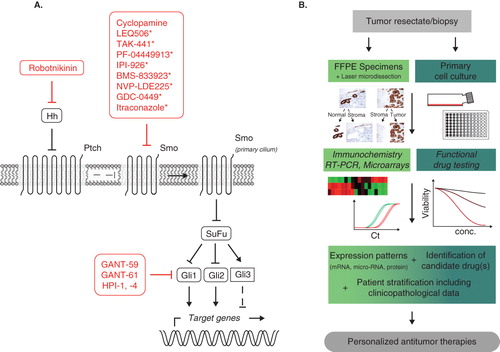Figures & data
Table 1. Hedgehog pathway in human cancers and current clinical trials.
Figure 1. Development of Hedgehog pathway-based antitumor therapies. A. The Hedgehog pathway and antagonists. In the absence of Hedgehog ligands (Hh), the transmembrane receptor patched (ptch) inhibits the smoothened (Smo) co-receptor. Subsequently, suppressor of fused (SuFu) deactivates Gli1, -2 transcription factors while activating the transcriptional repressor Gli3. Signaling mechanisms in the absence of ligands are indicated with dashed lines. In the presence of ligands such as sonic Hedgehog, Smo translocates to the primary cilium and releases the repression of Gli1, -2 via interaction with SuFu (the repressor Gli3 undergoes proteasome-mediated degradation). Pharmacological agents targeting Hh ligands, the Smo receptor or Gli transcription factors are shown in red. Those currently investigated in clinical trials (Phase I–II) are marked with an asterisk (see also ). B. Operational procedure for the establishment of Hedgehog-based personalized antitumor therapies. Establishment of individualized tumor treatment includes comprehensive molecular characterization (mRNA, microRNA, protein expression and functional testing of candidate drugs in primary cell cultures – culminating in rational patient stratification including clinicopathological characteristics).
